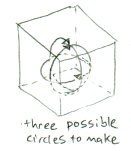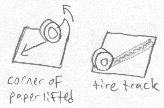
Imagine Bob has a tire (which is a type of cylinder) on a piece of paper. The tire is on one of the corners, and Bob lifts up the corner. The tire will travel to the opposite corner of the piece of paper, leaving a rectangular track behind it. Here is what it would look like:

Emily could do a similar thing in tetraspace. She has a swock and a tetratire. A swock is a four-dimensional piece of paper, which would be a cube in realmspace. Her tetratire is a type of cubinder, which is confined to movement along a line. If she sticks her tetratire on one corner of her swock, at lifts the corner "upsilon" (4D up), it would roll to the opposite corner of the swock. If her swock is laid flat onto realmspace, here is how the track would look across it:
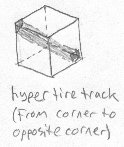
Bob can have his tire pointing in any direction to another side of his piece of paper. No matter how he lifts his piece of paper, the tire would either travel straight to the side it's pointing to or just fall over.
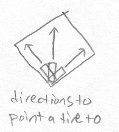
Emily can also point her tetratire in any direction she wants to. She has a lot more directions to point it to than Bob does:
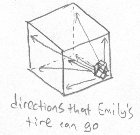
If a tire drove straight over the middle of a piece of paper, parallel to two of its sides, its track would look like this:
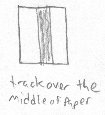
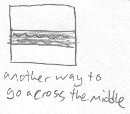
In the tetraspace, if a tetratire drove straight over a swock parallel to two of its sides, its track would go right through the middle. This means that there are three paths a tetratire can take, as opposed to Bob's realmic piece of paper, where there were only two. There is an extra parallel path for each dimension.
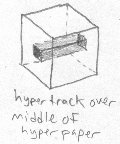
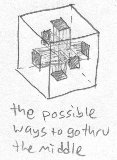
If you shine a light over the top of a wheel, its shadow would look like this:
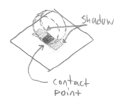
Notice that the shadow is two dimensional. The tire doesn't actually touch the paper except at the contact point, but it lies above all the points where the shadow is. Similarly, the shadow of a tetratire would look like this in realmspace:
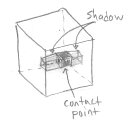
The tetratire only touches realmspace at the contact point, and the rest is a shadow of the tetratire in tetraspace. If a realmic tire is flat, it touches more of the paper at once, spreading out; if it is filled with air and very tight, it touches less of the paper at once:

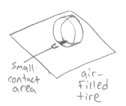
Similarly, a tetratire would cover more "volume" if it was flat, and less if it was full of air:
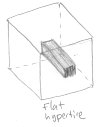
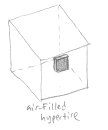
If a tire has some sort of pattern on it, and you watch only the contact area of the tire, it's the same as taking binoculars and sweeping them across a scene to see a little bit of the scene at a time. If you focus on the area at the bottom of the tire and track the binoculars as the tire rolls, you know that the tire doesn't "drag" along the surface it's rolling on, it "rolls" along the surface.

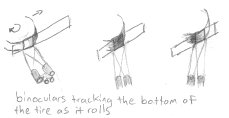

The same type of thing will happen with a tetratire. If you watch only the contact point, you will see the dark area "passing", but it isn't actually dragging, it's rolling along the "flat" 3D surface:

When falling, as a tire tips to its non rolling side, its contact surface will lift from the ground and only a line will be in contact with the ground. When it hits, a circle will suddenly appear two-dimension wise. Here is how it looks:

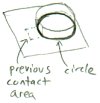
A tetratire would have a total of four directions to fall to. Here is a picture of all the possible ways a tetratire could fall:
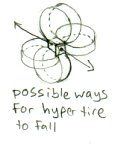
A spherical tetratire (which is a type of spherinder) has four directions to move to and two directions to tip to. A spherinder is less likely to fall over, but it will roll around a lot more. Here is a picture of its roll directions and the spots it can fall to:
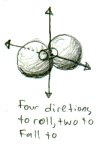
The track shape for a tetratire or cubinder is a cube, while the track for a spherinder or spherical tetratire is a cylinder. For a glome, the track is a sphere. The duocylinder, which is not pictured, has a cylindrical track, but it's direction of movement is along the symmetry axis. Here is a table and illustration for each:
| tetrashape | track on 3D surface |
|---|---|
| cubinder | cube |
| duocylinder | cylinder |
| spherinder | cylinder |
| glome | sphere |
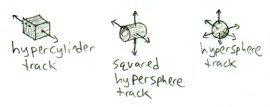
Picture Bob holding a book in the air. He has a ball on the surface of the book. If Bob moves the book around in a circle, the ball will travel in a circle in the opposite direction. The ball is basically moving in a circle around a linear axis:

Emily would be able to do the same thing with a tetrabook. Her ball is called a gongyl, the solid counterpart of the glome. The gongyl would have 3 axes to circle around, instead of just one for Bob's ball.
